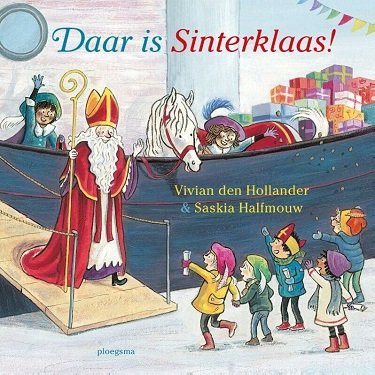traditionally dutch! Sinterklaas
Sinterklaas is a Dutch tradition that is celebrated on the evening of the 5th of December, but the traditions associated with Sinterklaas already start in November. This highly anticipated and iconic celebration is a truly exciting feast for Dutch children!
From a foreign perspective the Dutch celebration of Sinterklaas may seem like Christmas, but Sinterklaas is not Santa Claus! The Dutch Sinterklaas is based on the christian Saint Nicolas. He is also celebrated in Italy, France, Germany, Greece and Czech Republic, but also in the Middle East and some parts of North America. The Sinterklaasfeest is one of the most iconic Dutch celebrations that is celebrated in a similar way in Belgium, Luxembourg, Suriname and other former Dutch colonies.
WHO IS SINTERKLAAS?
Sinterklaas is an elderly and stately man who arrives in the Netherlands by stoomboot from Spanje. He is an elderly man with white hair and a lange baard and wears a rode mantel and mijter. He rides around on his witte paard and walks with his gouden staf.
The Dutch Sinterklaas is based on the Greek bishop Nicolas of Myra, who was born in Lycia, in current day Turkey. He died on the 6th of December 342 and in the 13th century the Catholic church made the 6th of December the name day of Saint Nicolas. Like with Sint Maarten and other saints, the name day of Saint Nicolas is on the day that he died.
Saint Nicholas had a reputation for secretly giving cadeautjes to children and the poor, by putting coins in the schoenen left outside their house. In the middle ages, Saint Nicolas would visit catholic monastery schools and bring cadeautjes for the hard working students and punish the lazy. Children would also leave their schoen in church on the 5th of December in the hope to receive a cadeautje from Saint Nicolas. Dutch children still celebrate this today by putting out their schoen next to the open haard or the front door. They sing Sinterklaas songs and if they have been good Sinterklaas and his helpers, the Zwarte Pieten, will bring snoepgoed or a small cadeautje.
Woordenschat
To help you prepare for Sinterklaas you should learn the below words!
Nederlands |
Engels |
| Het feest | The celebrations |
| De mijter | The mitre |
| De rode mantel | The red cloak |
| De lange baard | The long beard |
| De gouden staf | The golden staff |
| Het witte paard | The white horse |
| Spanje | Spain |
| De stoomboot | The steam boat |
| De knecht | The servant |
| Het cadeautje | The present / Gift |
| De open haard | The fire place |
| De schoen | The shoe |
| Het liedje | The song |
| Het gedicht | The poem |
| De liedjes | The songs |
| Het snoepgoed | The sweets / candy |
SINTERKLAAS WASN’T ALWAYS GOOD
Originally the feast of Saint Nicolas was a catholic celebration, however the Netherlands is now a protestant country and during the reformation, catholic celebrations fell out of favour in the Netherlands. Around 1600, some parts of the Netherlands even outlawed the catholic celebration of Saint Nicolas.
Saint Nicolas became a representation of the catholic religion and Saint Nicolas changed into a boogieman. His mantel and mijter became black and he wore chains and bells, to scare the children. If you were naughty the black Saint Nicolas would come and get you! In Germany and Czech Republic Saint Nicolas is still depicted in green and scares the children.
Even though the Sinterklaasfeest got banned, the feest remained popular and Saint Nicolas never completely disappeared. In 1850, a Dutch teacher wrote an illustrated children book about Saint Nicolas and this book forms the bases for the current Sinterklaas tradition. The book reinvents Saint Nicolas into Sinterklaas and makes him good again. He becomes red again. It also introduces Zwarte Piet and some believe that the black Sinterklaas may have been the inspiration for Zwarte Piet.
SINTERKLAAS VS SANTA CLAUS
Are Sinterklaas and Santa Claus the same person? Well yes and no.
As you now know, Sinterklaas is based on Saint Nicolas and we celebrate Sinterklaas on the 5th of December and not with Christmas. However, Sinterklaas is part of the origin story of Santa Claus.
Dutch settlers which settled in America, took with them their Dutch traditions like Sinterklaas and continued to celebrate the Sinterklaasfeest in America. The British settlers did the same and brought with them Father Christmas. Over time the Dutch Sinterklaas and the British Father Christmas merged together and became associated with Christmas. Coca Cola gave Santa a make-over and thanks to commercialisation, Santa Claus made his way back to the Netherlands.
The Dutch now also know Santa Claus (or the Kerstman as we call him in Dutch). Santa is depicted on Christmas cards, wrapping paper and seen in movies, but the Kerstman is nowhere near as popular as Sinterklaas and he is still a fairly new phenomenon.
So Sinterklaas is not the same as Santa Claus, but you can clearly see similarities between Sinterklaas and Santa Claus traditions. What similarities have you noticed?







